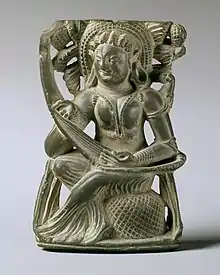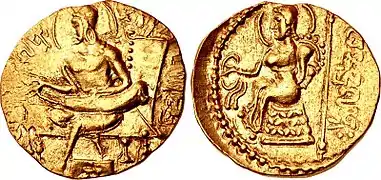Ancient veena
The ancient veena is an early Indian arched harp, not to be confused with the modern Indian veena which is a type of lute. The instrument is attested on a gold coin of the Gupta Empire from the mid-300s CE.[1][2][3] The instrument was also illustrated in the oldest known Saraswati-like relief carvings, from Buddhist archaeological sites dated to 200 BCE, where she holds a harp-style veena.[4]

Generic meaning of veena

The Sanskrit word veena (वीणा vīṇā) which is attested already in the Rigveda has designated in the course of Indian history a variety of instruments of various types, as it is a generic term for all kinds of string instruments, just as the Tamil word yazh (யாழ் yaaḻ). In the last centuries and today the instruments designated under the designation veena of which there are several kinds, have tended to be mostly instruments of the lute or cithar type, and recently the word was even applied to modified Western guitars. But the early veenas could be plucked string instruments of any type.
Early Gupta vina

One of early veenas used in India from early times, until the Gupta period and later (this is probably the instrument referred to as veenaa in a chapter of the Nāṭyaśāstra dealing with instrumental music)[5] was an instrument of the type of the harp and more precisely of the arched harp. It was played with the strings being kept parallel to the body of the player, with both hands plucking the strings, as shown on Samudragupta's gold coins[6] It is not possible to tell exactly the number of strings of the instrument on the coin, but descriptions in early literary sources of an ancient instrument called the saptatantree veenaa (7-string veenaa) seem to coincide generally with the type of instrument represented on the coin. In the Nāṭyaśāstra this 7-string veena (played with the fingers, as opposed to the 9-string vipanchi played with a plectrum) is called a citra.[7]
The depiction of king Samudragupta holding such an instrument on his gold coins testifies of the popularity of the instrument, and also of the interest in music and the arts of a king who was also one of the greatest military conquerors in Indian history.[8]
Descendants
.jpg.webp)
From India this type of instrument was introduced into Burma at an early period (by the 8th century CE and possibly as early as 500 CE,[9] where, while instruments of this type have disappeared from India itself, it is still played, generally with 15 strings, under the name of saung (known in the West also as the Burmese harp).[10][11][12]
The Cambodians have recreated their ancient harp, the pin. The instrument appeared in Hindu religious art in Khmer temples dating back between the 7th and 13th centuries A.D.[13][14][15]
References
- "Coin, Samudragupta". The British Museum.
Gold coin.; Samudragupta, seated on a high back couch, facing to the left, wearing a waistcloth, ear rings and necklace. Has halo around head. Holds a lyre/vina in his lap which he plays.
- "The Gupta Empire : A Time of Great Prosperity and Achievement in the Elites". 5000 years of Indian History. 17 October 2016.
Photo of unworn coin, showing detail in the veena.
- "The Coin Galleries: Gupta: Samudragupta". CoinIndia.com.
[The coin is in the 12th image down, under the title "Lyrist type."]
- Catherine Ludvík (2007). Sarasvatī, Riverine Goddess of Knowledge: From the Manuscript-carrying Vīṇā-player to the Weapon-wielding Defender of the Dharma. BRILL Academic. pp. 227–229. ISBN 90-04-15814-6.
- Nāṭyaśāstra, XXVIII, 4-5 (the veena is also used and described in other shlokas which follow 4-5 in chapter XXVIII)
- "The Coin Galleries: Gupta: Samudragupta". CoinIndia.com.
- Nāṭyaśāstra, XXIX, 120
- "The fact that the king wanted to publicize an image of himself as a musician is remarkable and a window into the value system of the Gupta state" Coin India site Catalog and description of the gold coins minted during Samudragupta's reign (Web page)
- Judith Becker, The Migration of the Arched Harp from India to Burma, The Galpin Society Journal, vol. 20, pp. 17–23
- Śrīrāma Goyala (1 August 1992). Reappraising Gupta History: For S.R. Goyal. Aditya Prakashan. p. 237. ISBN 978-81-85179-78-0. - ...yazh resembles this old vina... however it is the Burmese harp which seems to have been handed down in almost unchanged form since ancient times
- According to the site Harp History a similar instrument is played in Thailand. A photograph of the Thai harp is shown on that site.
- Ank van Campen, Iconography: Pictures Existing instruments on the Harp History site (Web page)
- Rosa Ellen (10 May 2013). "The living sound of Angkor".
Like a bass relief coming to life, the boat-like pin has been recreated purely from 12th century images carved on the walls of Angkor Wat and Bayon... Image of pin, played by Snguon Kavei with luthier Keo Sonan Kavei (the musician's father.
- Koam Chanrasmey (8 July 2013). Pin, the Sound of Angkor [Pin, the Sound of Angkor]. Phnom Penh, Cambodia: Phnom Penh Post. Retrieved 27 October 2018.
- "Cambodian folk Music". Women's Media Center of Cambodia. Retrieved 27 October 2018.
According to experts, the "harp" is a kind of traditional Khmer instrument from native to India. " Harp "has existed in Cambodia since the 7th century and disappeared in the late 12th century or early in the 13th century, according to Keo Sorunwy, professor of the Faculty of Education, Trei Royal University of Fine Arts.
Bibliography
- Judith Becker, The Migration of the Arched Harp from India to Burma, The Galpin Society Journal, vol. 20, pp. 17–23
- Terry E. Miller and Sean Williams. The Garland handbook of Southeast Asian music. Routledge, 2008. ISBN 0-415-96075-4
- Muriel C. Williamson The Burmese Harp: Its Classical Music, Tunings, and Modes, Northern Illinois University Center For Southeast Asian Studies, 2000
- Arthur Llewellyn Basham, The Wonder That Was India, Scholarly Publishing Office, University of Michigan, 2008, 696 pp.
- The Natyasastra (Vol. 2): A treatise on Hindu dramaturgy and histrionics (Chapters 28-36) (translated by Manomohan Ghosh), 1961, Calcutta, Asiatic Society of Bengal (Biblioteca Indica); reprint: Chaukhamba Surbharati Prakashan, 2016, Varanasi